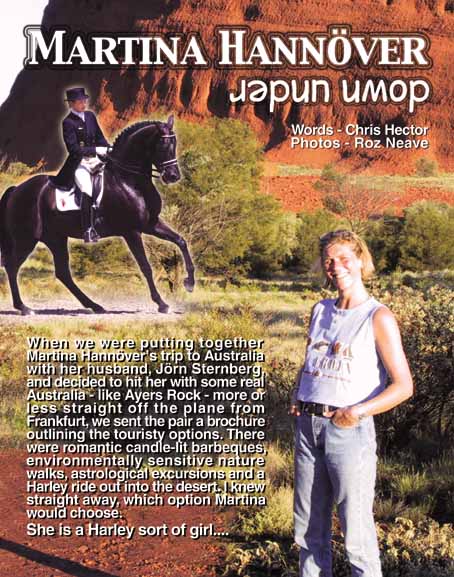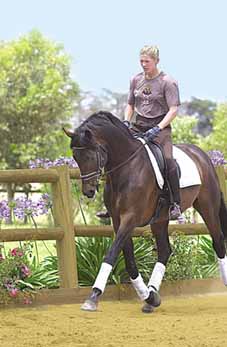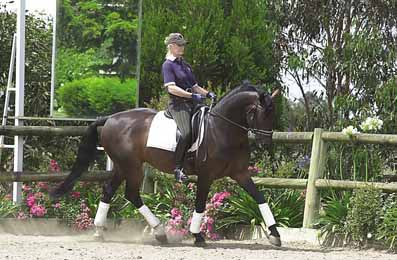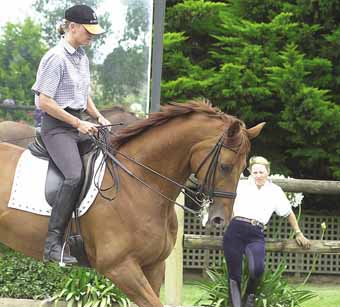Sure enough when the pair finally made it to Melbourne for the first of the Heatherton Park Summer Schools, they were still buzzing with the excitement of their high speed scenic burn on the big bikes around the red heart, and really things didn’t get much slower until we finally packed Martina back on the plane home – she is very much a full-on sort of lady.
Full on, generous, warm, giving and wow what a teacher! It was amazing to see the difference in the horses after a just a few days, and mostly it seems to come from a critical couple of centimetres in the length of the neck, but really it is not the neck itself that is important, it is what the neck shows us about the rest of the body, most importantly, the other end, the hind end, and the level of engagement and ‘forward’. The key thing that Martina seemed to be able to get across was that you could generate that amount of forward without feeling the need to grab hold of the horse in front. Then the power behind could stay loose and elastic, then the contact in front could stay sweet and light.
None of this is new. It is the sort of thing that dozens, nay hundreds of good instructors have attempted to communicate. The difference perhaps was that Martina could get on board (often in running shoes and without spurs) and produce the result herself. But perhaps none of those hundreds of other instructors have quite Martina’s experience – four and a half years working at Grohwolhdhof with the late great Herbert Rehbein, followed by three years with Jo Hinnemann and Ernst Hoyos while she was working at the famed Vorwerk Stud, and more recently as the German hierarchy realise how important Martina’s front-liner, Ratina H might be for their future hopes, time with national coach, Holger Schmetzer, and with an open invitation come and work with super coach, Klaus Balkenhol.
One of the interesting horses Martina worked with at Jim and Emmie’s Heatherton Park, was the imported stallion, Möet (above). Purchased by Lesley Ann Taylor from the famous PSI dressage barn, Möet is very much the modern Warmblood type – elegant and very very pretty. After a couple of lessons with Martina he looked even prettier, moving so much more freely and with that crucial couple of extra centimetres in front.
Möet’s owner, Lesley Ann Taylor was rapt after the lessons: “It’s very relevant for me because I’m riding a young stallion, and Martina’s has ridden so many fabulous stallions – like Rubinstein. Stallions can be different, and a bit tricky but I love them, and I know she does. She also loves working with young horses so it’s even better for me.”
“What I learnt was a confirmation of how much more I can ride him out into the frame, sending him forward to the contact. I suppose a lot of us get pre-occupied when we start doing the test work, and even though when you are teaching yourself you are stressing the importance of the foundation and the basic training, you very easily get a little bit side-tracked yourself. For me it was great, I felt the horse reached so much more, the paces developed with the swing through his back. Stallions tend to get a little tight in the neck and hold themselves, you get a little bit of tension in the mouth, then tension in the back can block the hind legs.”
It was interesting how quickly Martina solved the mouth thing – she said ‘play with the bit’ a little.
“I think it was also because we were sending him forward so much without losing the rhythm that it was easier for the horse to travel into the contact. I could feel in a more positive sense, rather than – not meaning to – but working a bit from the front to the back. Martina understands stallions, instead of getting stronger with him, or trying to tighten the nose band, it was a really subtle feel, it’s not fiddling, it’s not swinging them, it was just into the hand and as she said, ‘let the bit feel a little more on his tongue’ and he was really good in the mouth.”
Martina was interesting in her analysis of Möet:
“I just thought he wasn’t relaxed enough when Lesley started on some exercises, he wasn’t happy and chewing in the mouth. Today it felt good and it looked better, so I think we did the right thing yesterday. Yesterday he was a little bit too tight in the neck without being round and over the back. So we have to ride a lot of transitions, also checking that he is straight – here in Australia I have seen so many riders and so many horses, and the riders don’t think enough about having the horse straight. If you don’t have the horse straight you can’t feel the push coming into your hand, sometimes you have to push a little bit more with the left leg, or a little bit more with the right, to get the right feeling in the hand. If riders don’t have the horse straight then they will never get this feeling of the horse being over the back, and that is the most important thing – to make horses go well over the back and allow them to come more under with the hind legs.”
Is this partly the problem that they are riding on the wall? (Martina was absolutely fanatical at getting the riders to use the inside track…)
“Yes, because if you let them, horses find their balance on the wall and the rider doesn’t recognize what is going wrong. The rider is still pushing forward with both legs but doesn’t feel that the horse is a little bit more sensitive on the left leg or is heavier on the right leg. The rider can’t recognize those things because the horse does not show them, he is getting his balance from the wall.”
“Everybody has to be able to ride with longer reins – does the horse let you sit? Does he accept the leg? That is always the sign that there is something going wrong – if they go against your hand. It doesn’t mean that you don’t have the rein, it’s like a rubber band but you have to learn to control the horse more and more on the outside and not so much hold them on the inside rein.”
Monica Bird and her horse, Argentille Gabriella are a delight to watch in work because they always seem to be trying so honestly to improve, and it was interesting to see the pretty chestnut mare working with Martina. Again, the transformation is pretty radical. The mare has always had the tendency to roll over in front, suddenly she is just that tiny bit more open in the gullet, and suddenly she is stretching, looser, longer, more athletic, more switched on…
Monica has had the eight year old Gabriella since she bought her at the Lochinvar Auction as a two year old. She is by the Dutch stallion, Gullit and out of a mare by the Hanoverian, Winterkoenig. “She had three weeks work when I bought her,” says Monica. “I put her out for a year and started her again when she was three, that was the right thing to do I think.”
And what do you think you’ve got out of the school with Martina?
“Well I first came here to work on the flying changes and I think I’ve done only about ten changes in the whole three days! Martina said I had a problem with my basics. She thought the horse wasn’t waiting enough in the collected paces, and I felt that too. She creates a lot of energy, but I can’t quite sit it back enough, so in the changes, she is changing early in front. I’ve probably spent at least twelve months asking why? Why can’t she change? Martina has just hit the button and said this is why – she’s got to sit, she’s got to wait. A lot of riders wouldn’t like to have to go back to basics on a Medium horse but how she is going now is great. She feels better – all those things like half pass and shoulder in, they haven’t gone away, I can get them back but first I’ve got to work on her waiting for my aids and not just going along. I feel I don’t spend enough time on every single stride. Even in the free walk, Martina said ‘she must be deep, she must be round, she can’t go to sleep’.”
“That’s the other thing I’ve got out of the clinic, Martina’s expectation of ‘deepness’ is so much deeper than anyone else has ever explained to me. I think is was on the first day, she said to me ‘you’ve got to play with the horse’, that gave me a sense of relaxed elasticity. Playing – it’s relaxed, and it’s fun but they do have to stretch and you can move the horse forward and back, but they still have to be deep and round and over the back. That’s huge for me. I’m just an average rider and to be able to relate to someone of her calibre, and understand what she was saying was great, and to see her ride was just mind boggling. She gets on – and not only my horse but the others she has ridden – and it takes half a circle, if that, and the horses are in gear and off they go. She is just unreal, I don’t know why more people didn’t come to watch, because it is such an opportunity to listen to someone of her calibre, and for her to come to Australia to begin with… what an opportunity.”
Back to Martina…
Were the clinics here in Australia how you expected they would be?
“I’m giving clinics in lots of countries and it is all much the same. There are some better riders and some not so good riders. Most of the riders here are the way I like them – they love their horses and have fun, they enjoy learning, and that’s what I want to do with my clinics. I’ve had fun too – especially when we had less lessons in the day, because it is so hard when you want to do the same thing for everybody, and you start early in the morning and you have eleven or twelve people , you can’t do it because your concentration can’t stay for so long. I really try, not just to look into the horses but also into the people to try and make it easier for them to understand. Sometimes the riders when they come to a clinic are a little bit tense, and that makes it hard for them. You have to see every second what they are doing. Even when I am sitting there for the first five minutes or so watching the horse – I want to find the point, the reason the horse is not going so well, then you can help, and this needs from me a lot of concentration.”
The horses all look so much more energetic after you have worked with them, as if someone has turned on the ‘go’ button…
“Some of the horses felt like that. Most of the riders they hold their horses too much, they are not thinking about going forward, they are thinking about their seat. They distort the horse because they hold it so much on the inside rein, and in the moment they ask them to go forward they pull them back. The horse can’t understand that, then they get tired of the leg, and then they get tense and shorter in the trot. It’s hard for them to change it.”
One rider whose horses really bloomed under Martina tuition, was clinic organizer, Emmie Schmul (seen below watching Martina work her horse Aarchon).
“Martina taught me a bit more patience, and to listen to what my horse is trying to tell me, to put a little bit more fun and play in the way I ride. That’s the important thing, to get fun back into it, whether it is piaffe or passage. Keep the forwardness but play with it all. Don’t do miles of it so it keeps it bright.”
Looking from outside the arena, what was interesting was that Martina got you to give Aacheron lots more space out in front, and when you did that, he thought ‘great I can play tricks now’ but she stopped you grabbing the rein back, and made you work with your legs instead to control the horse…
“Instead of trying to hold him together and then push him into it, she said he had to be more responsive to my leg, more forward to the leg, and with a new sharpness. She said ‘keep the neck steady, and use your leg to create the rest of it’. Normally you are trying to make them supple and you end up moving them too much. For the first couple of days, she wouldn’t let me move anything with my hands, and I just had to ride him with my leg and seat, and then after a couple of days, she made me move just slightly with my fingers, which is what everyone tells you to do, except we usually try too much and try to bend them. She stressed, it is your leg and seat first.”
It seemed to happen with almost all the horses – they ended up longer in front and much more energized behind…
“It was interesting with the riders that did the two clinics, on day five everything had changed from day three. If you did the three days, then the message was that you were not allowed to pull on the inside rein, because Martina was trying to get the rider with more feel in their leg and seat. In the second clinic, she said ‘now start to use your hands and start to bend him and make him more supple’. Then she was always adjusting the horse with her legs, adjusting to keep them sharp. I get into my head that I want to get the horse forward so I’ll hammer them forward whereas Martina is always adjusting the horse, forward, then back, then forward as much as the horse will allow you to go forward. Even if you want a 10, and you are only getting a 3, work on that until you get a 4, then a 5 and a 6, not so you go for 10 straight away.”
“It was nice to see Martina ride piaffe and passage on ‘Ulli’, it was nice to see him so bright, and not afraid of that work. When I do that work I’m not sure what to do with it when I get him like that. She said, everything is there, he can do it all, it is just a matter of getting him more in front of my leg. Her being a female is really good, we have a lot of men here – it is not that we do anything so much different, it is just that we don’t have the same amount of strength, it is so interesting the way she is adjusting it all the time, keeping the horse so he is ready to just – whoosh – go! He is not too sure what is going to happen next.”
She was so enthusiastic as a teacher…
“She got so much enjoyment out of teaching everybody. If the students didn’t get it and quite understand, she was disappointed in herself, she wanted to leave them with something to go on with. She was really fun to work with, but she got tired, because she puts such a lot into her lessons.”
Certainly Martina put a lot into her lessons with Emmie and Ulli but equally she was delighted with the result, saying this was no ‘normal’ horse, but one that could go well even in European competition, as long as Emmie listened hard:
“I noticed that he got a little behind the bit, and Emmie got back into her bad habits. She is good if everything is fine – on her young horse she was super today, but if something happens she starts to pull again on the left rein. I rode the horse to demonstrate that I can very quickly motivate him to work, can ask him everything. Then I put Emmie back on. I wanted to show that even with a horse that is nearly Grand Prix, you have to do the basic work. So I tried to work Emmie and him in trot and canter, just a nice trot really into the hand and forward from behind into the front steps, and do the transition to canter, because he comes behind better when she comes with the leg.”
“You can work on that much better in just basic exercises – like doing trot, and little half halt into canter, and then pushing him forward, and then you could see where the problem was. He was going against the bit when she came with the leg, and she just has to tell him not to do it, and train him again and again, making him really nice in front in the trot before you start canter. Then you won’t have this problem when you ride the more advanced movements. But if you try to fix the problem while you are riding more difficult movements, you get in trouble, because some younger horses, they get tense when they are asked for something where they have to work hard. It is easier for them to understand in the basic work.”
What was also fun for Martina was the range of pupils she worked with. One thrill was working with Australian eventing gold medallist Stuart Tinney:
“He’s a professional. He was riding at the Olympic Games and I heard he went not so bad (Martina is laughing at this point, if you still have a stereotype of the glum German, you obviously haven’t been within 100 metres of Martina Hannöver!) but I hadn’t met him because I am busy with my dressage. With Stuart you could see from the beginning that he wanted to do it without getting stressed, and he was 200% concentrated. He could listen to his horse and hear what the horse is telling him. Especially with these hot three day event horses, they need a rider who is listening to them, who is seconds in front of the horse, not late and waiting for things to happen. Working with Stuart was a lot of fun because it was amazing how fast he picked up what I meant. Some of the other riders it took them a day to understand me, until they could feel what I was talking about but with Stuart it was straight away.”
It seemed that with every horse you worked with, the frame got longer, the front was longer after a couple of lessons?
“It is not so easy to say this in English, what I try to do is let the horse go forward, straight into the hand. I want to make Schubkraft – the power to thrust with the back legs, they go more and more under, and more and more forward, when the horse is straight and loose in front, then you get a nice steady contact. Then with my half halts I want to turn this energy back, so Schubkraft goes into Tragkraft, the power to carry, so they get more and more under with their hind legs, and all by themselves they come up in front.”
It was interesting when you gave the horses that extra space in front, then sometimes they responded by trying to play around in front, or roll over in front, but you were stressing not to react with the hands but to control them in front with your leg…
“Giving a little bit of impulsion with the leg so that they go back into the hand, because if I do more with my hands I am pulling them more and more behind the bit. That’s not what we want. We want the horse listening to our legs, without getting tense on our legs – to trust the aids that we give them and push them into the bit. But we must ask them – we can’t just say ‘come on’ with the legs or the horse will go against the hand, and that is not what we want. We have to wait until the horse is able to do it, and then ask.”
Most of the time you rode without spurs – why?
“I didn’t have any. At home I ride with spurs, I think you should ride with spurs, even with the younger horses – short spurs. But also I wanted to show the riders, because they have longer and longer double bridle bits and longer spurs, and I tried to show them to ride on the snaffle, even in the double bridle, so you don’t lie to yourself. And the same, I was riding without spurs, because the riders say ‘oh I can’t get my horse forward’ and they take longer and longer spurs, and then they are in trouble with the horse. They start pulling back too much, and using the spur too much, and this is a circle with no end.”
You don’t mind teaching not so experienced riders if they have a good attitude?
“They can decide themselves if they want to spend so much money on a basic lesson. I enjoy more teaching people who really want to learn something. I mean I don’t want to come all the way to Australia to teach twenty people who have only been riding for half a year, but if there is one in every clinic, then that is great as long as they have fun, and as long as they treat their horse nicely. You really could see how much the less experienced rider enjoyed the lesson, and how much she learned, and she had such a nice horse, and she loved her horse, and that made me happy to. I really want to have harmony. I think dressage is harmony between rider and horse.”





